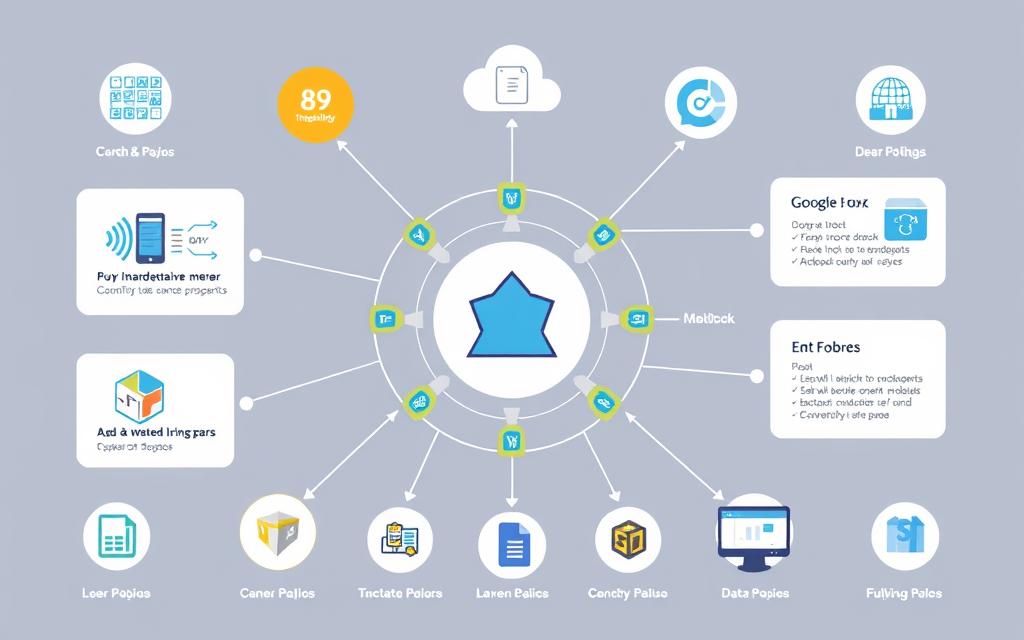In today’s data-driven landscape, businesses are sitting on vast amounts of information. However, the challenge lies in organising this data to unlock its true value. A well-organised dataset is the foundation for successful artificial intelligence (AI) implementation.
Effective data management is crucial for business success in the AI era. Proper organisation of data assets enables companies to harness the full potential of AI technologies.
By understanding the importance of data organisation and implementing a strategic framework, businesses can overcome common challenges and achieve accurate, helpful machine learning tools that drive business objectives.
The Foundation of AI Success: Why Data Organisation Matters
The effectiveness of AI systems is directly tied to the quality of their underlying data organisation. For a company to build a sustainable AI system, it must have high-quality data and the right methods to classify and access it.
In many industries, such as insurance, advertising, and manufacturing, data often arrives in inconsistent formats, making it challenging to manage. A data warehouse may contain various types of data stored across different systems, each with unique storage formats.
The Link Between Data Quality and AI Performance
Data quality is fundamental to AI performance. Poorly organised data leads to the “garbage in, garbage out” phenomenon, undermining AI effectiveness. Key data quality metrics, including accuracy, completeness, consistency, and timeliness, directly impact the effectiveness of machine learning algorithms and AI models.
- Accuracy ensures that the data is correct and reliable.
- Completeness guarantees that all necessary data is present.
- Consistency checks that the data is uniform across different datasets.
- Timeliness confirms that the data is up-to-date.
Business Value of Well-Organised Data Assets
Properly organised data assets create tangible business value by improving decision-making, operational efficiency, and competitive advantage. Well-structured information systems enable AI to extract meaningful patterns and insights that would otherwise remain hidden.
Strategic data management practices are critical to deriving maximum value from AI investments. By focusing on data organisation and management, businesses can establish a solid foundation for AI success.
Common Data Organisation Challenges for Existing Businesses
Implementing AI solutions requires well-organised data assets, a feat many existing businesses struggle to achieve. The organisation of data is crucial for the success of AI initiatives, but several challenges hinder this process.
Data Silos and Inconsistent Formats
Existing businesses frequently struggle with data silos that develop over time, where information becomes trapped within specific departments or systems without proper integration across the organisation. In many cases, data flows to a company in inconsistent formats, making it difficult to unify and standardise the data.

Legacy Systems and Integration Issues
Legacy systems present unique integration issues as they often use outdated technologies that weren’t designed with modern data governance frameworks or AI applications in mind. This results in significant challenges when attempting to integrate these systems with newer AI solutions.
Lack of Data Governance Frameworks
The absence of comprehensive data governance policies leads to confusion about data ownership, quality standards, and usage protocols. Establishing a robust data governance framework is essential to overcome these challenges and ensure the effective use of data assets.
| Challenge | Description | Impact |
|---|---|---|
| Data Silos | Information trapped within departments or systems | Limited data integration and accessibility |
| Legacy Systems | Outdated technologies not designed for AI | Integration issues with modern AI solutions |
| Lack of Governance | Absence of data governance policies | Confusion about data ownership and quality |
Assessing Your Current Data Landscape
Assessing your organization’s data infrastructure is a prerequisite for a successful AI strategy. Before implementing AI initiatives, it’s crucial to understand the quality, accessibility, and governance of your data assets.
Conducting a Comprehensive Data Audit
A comprehensive data audit forms the essential first step in understanding your organisation’s current data landscape. This process involves cataloguing existing data sources, formats, storage systems, and access protocols across your entire organisation. As noted by IBM, a data-driven organisation is one that “uses data to inform its decisions, and to drive business outcomes” (https://www.ibm.com/think/insights/data-differentiator/data-driven-organization).
Identifying High-Value Data Assets
The next step is to identify high-value data assets that have the greatest potential to drive meaningful AI insights and business outcomes. This involves evaluating the relevance and potential impact of different data sets on your AI initiatives.
Evaluating Data Quality and Accessibility
Data quality and accessibility are critical factors in determining the effectiveness of your AI strategy. Techniques for evaluating data quality dimensions include assessing accuracy, completeness, consistency, timeliness, and relevance. A data quality assessment can be summarised in a table like this:
| Data Quality Dimension | Description | Importance for AI |
|---|---|---|
| Accuracy | Data is correct and reliable | High |
| Completeness | Data is comprehensive and covers all necessary aspects | High |
| Consistency | Data is consistent across different systems and sources | Medium |
As highlighted in the quote, “Data is the new oil, but only if it’s refined” – the process of assessing and refining your data is crucial for AI success.
By following these steps, organisations can gain a clear understanding of their current data landscape and identify areas for improvement to support their AI initiatives.
How Existing Businesses Should Organize Their Data Assets for AI
To effectively leverage AI, existing businesses must first organize their data assets in a coherent and accessible manner. This involves acknowledging that the data driving a business is fundamentally one cohesive set of information rather than disconnected pieces or systems.
Enterprises often overlook data management issues until they become unmanageable. Defining data formats and organization at the onset is a strategic move, as the costs of doing it wrong are substantial in the aggregate.
Establishing a Unified Data Architecture
A unified data architecture provides the structural foundation that enables AI systems to access and process information efficiently across the organisation. This involves standardising data formats and implementing master data management practices. By doing so, businesses can create a centralised repository, such as a data lake or warehouse, that serves as a single source of truth.

Implementing Data Classification and Tagging Systems
Implementing robust data classification and tagging systems creates the necessary metadata that makes data discoverable, searchable, and usable for AI applications. This process involves categorising data assets based on their relevance, sensitivity, and business value, thereby facilitating more efficient data organisation.
Creating Clear Data Lineage Documentation
Creating clear data lineage documentation helps track the origin, transformations, and movement of data throughout its lifecycle, ensuring transparency and trust. This documentation is crucial for understanding how data assets are utilised and for identifying potential issues in data management.
| Data Organisation Strategy | Description | Benefits |
|---|---|---|
| Unified Data Architecture | Standardising data formats and implementing master data management practices. | Efficient data access and processing for AI systems. |
| Data Classification and Tagging | Categorising data based on relevance, sensitivity, and business value. | Improved data discoverability and usability for AI applications. |
| Data Lineage Documentation | Tracking data origin, transformations, and movement. | Enhanced transparency and trust in data assets. |
Building an Effective Data Governance Framework
Establishing a robust data governance framework is crucial for organisations seeking to maximise the value of their data assets. This framework serves as the foundation for managing data effectively across the organisation, ensuring that it is handled in a way that supports business objectives while maintaining regulatory compliance and ethical standards.
Defining Roles and Responsibilities
A key aspect of an effective data governance framework is the clear definition of roles and responsibilities. This includes identifying data stewards, owners, and custodians, and outlining their specific duties to ensure accountability and proper data management. The CDO Council framework highlights the importance of defining data ownership and stewardship responsibilities.
Setting Data Quality Standards and Policies
Establishing data quality standards and policies is vital for ensuring that data is accurate, complete, and consistent. These standards define acceptable thresholds for data quality, enabling organisations to make informed decisions based on reliable data. By implementing these standards, businesses can improve the overall quality of their data assets.
Ensuring Regulatory Compliance and Ethics
Ensuring regulatory compliance and maintaining ethical standards in data usage is critical. Organisations must comply with data protection laws such as GDPR and CCPA, and adhere to ethical principles in their data practices. This involves developing comprehensive data security, compliance, and governance policies that align with organisational goals.
| Key Components | Description | Benefits |
|---|---|---|
| Roles and Responsibilities | Clear definition of data stewards, owners, and custodians | Improved accountability and data management |
| Data Quality Standards | Establishing thresholds for accuracy, completeness, and consistency | Reliable data for informed decision-making |
| Regulatory Compliance | Adherence to data protection laws and ethical standards | Reduced risk and enhanced trust in data practices |
Essential Technologies for AI-Ready Data Management
The key to unlocking AI’s full potential lies in having a well-organised data management system. To achieve this, businesses must leverage the right technologies that enable efficient data processing, governance, and integration.
Data Integration and ETL Tools
Modern data integration and ETL (Extract, Transform, Load) tools are essential for connecting disparate data sources and transforming data into standardised formats suitable for AI processing. These tools enable organisations to consolidate their data, ensuring it is accurate, complete, and in a usable format.

Data Cataloguing and Metadata Management
Data cataloguing and metadata management solutions create searchable inventories of data assets, making them discoverable and usable across the organisation. By implementing these solutions, businesses can improve data accessibility, reduce data duplication, and enhance overall data governance.

AI-Powered Data Governance Solutions
AI-powered data governance solutions utilise machine learning to automate data quality monitoring, policy enforcement, and compliance checks. These solutions enable organisations to proactively manage data risks, ensure regulatory compliance, and maintain high data quality standards.

The Role of the Chief Data Officer in Data Organisation
Effective data organisation is key to unlocking AI potential, with the Chief Data Officer playing a central role. The CDO is responsible for overseeing the management of data assets across the organisation, ensuring that it is properly utilised to drive business value.

Key Responsibilities and Skill Requirements
The modern CDO has a multifaceted role that includes data governance oversight, quality management, strategic planning, and fostering a data-driven culture. To be effective, a CDO must possess a blend of technical expertise, business acumen, and change management capabilities. Key responsibilities include defining data policies, ensuring regulatory compliance, and driving data innovation.
Building Cross-Functional Data Teams
To achieve successful data organisation, CDOs must build cross-functional teams that bring together diverse expertise from IT, business units, analytics, and compliance. These teams work collaboratively to identify high-value data assets, implement data quality initiatives, and develop skills necessary for effective data management. By doing so, organisations can ensure that their data assets are well-organised, accessible, and ready for AI implementation.
Implementation Strategy: From Planning to Execution
Implementing a data organisation strategy for AI requires a structured approach. A successful implementation strategy begins with careful planning that aligns data organisation initiatives with specific business objectives and AI use cases.
Starting with Pilot Projects
Starting with focused pilot projects allows organisations to demonstrate value, refine approaches, and build momentum before broader implementation. This phased approach helps in identifying potential challenges and making necessary adjustments.
Scaling Data Organisation Initiatives
Once pilot projects show promise, the next step is to scale data organisation initiatives across the enterprise. This involves change management strategies and resource allocation to ensure a smooth transition. Effective scaling requires a clear understanding of the organisation’s data landscape and the ability to adapt the strategy as needed.
Measuring Progress and Success Metrics
To gauge the effectiveness of data organisation efforts, it’s crucial to establish clear success metrics. These metrics should track both technical improvements in data quality and business outcomes. Regular assessment of these metrics helps in refining the strategy and ensuring it remains aligned with business objectives.

By following this structured implementation strategy, organisations can minimise risks and maximise the chances of success in their data organisation efforts for AI.
Conclusion: Transforming Data Assets into AI Advantage
In today’s data-driven world, transforming data assets into a strategic advantage is crucial for business success. Effective data organisation is key to unlocking the full potential of artificial intelligence (AI). By organising their data, businesses can drive innovation, efficiency, and competitive differentiation.
The journey to AI maturity is ongoing, requiring continuous improvement in data management. As AI capabilities advance, data organisation requirements will evolve. Businesses must prioritise data quality, governance, and accessibility to remain competitive.
By adopting a comprehensive data organisation strategy, businesses can transform their data assets into a valuable strategic resource, driving long-term success and transformation. For guidance on this transformative journey, consider enrolling in AI Essentials for Business to develop an AI strategy aligned with your business goals.





